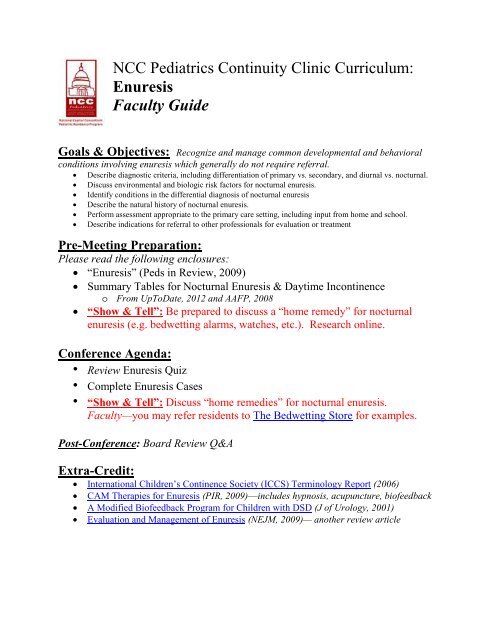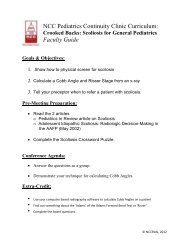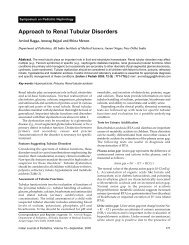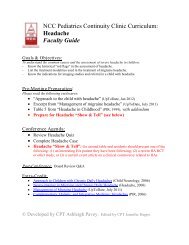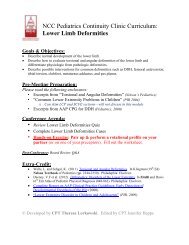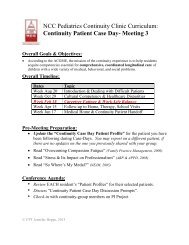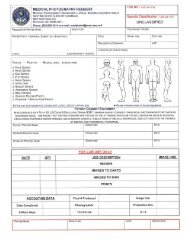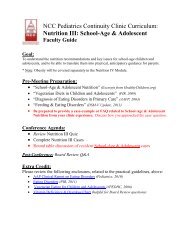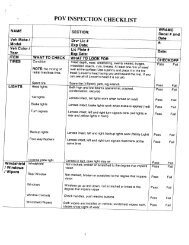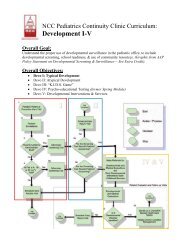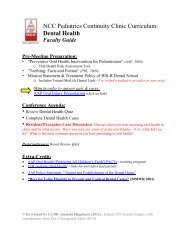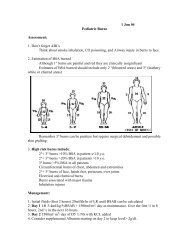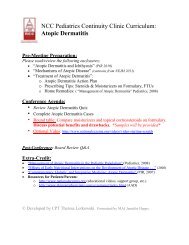NCC Pediatrics Continuity Clinic Curriculum: Enuresis Faculty Guide
NCC Pediatrics Continuity Clinic Curriculum: Enuresis Faculty Guide
NCC Pediatrics Continuity Clinic Curriculum: Enuresis Faculty Guide
Create successful ePaper yourself
Turn your PDF publications into a flip-book with our unique Google optimized e-Paper software.
<strong>NCC</strong> <strong>Pediatrics</strong> <strong>Continuity</strong> <strong>Clinic</strong> <strong>Curriculum</strong>:<br />
<strong>Enuresis</strong><br />
<strong>Faculty</strong> <strong>Guide</strong><br />
Goals & Objectives: Recognize and manage common developmental and behavioral<br />
conditions involving enuresis which generally do not require referral.<br />
• Describe diagnostic criteria, including differentiation of primary vs. secondary, and diurnal vs. nocturnal.<br />
• Discuss environmental and biologic risk factors for nocturnal enuresis.<br />
• Identify conditions in the differential diagnosis of nocturnal enuresis<br />
• Describe the natural history of nocturnal enuresis.<br />
• Perform assessment appropriate to the primary care setting, including input from home and school.<br />
• Describe indications for referral to other professionals for evaluation or treatment<br />
Pre-Meeting Preparation:<br />
Please read the following enclosures:<br />
• “<strong>Enuresis</strong>” (Peds in Review, 2009)<br />
• Summary Tables for Nocturnal <strong>Enuresis</strong> & Daytime Incontinence<br />
o From UpToDate, 2012 and AAFP, 2008<br />
• “Show & Tell”: Be prepared to discuss a “home remedy” for nocturnal<br />
enuresis (e.g. bedwetting alarms, watches, etc.). Research online.<br />
Conference Agenda:<br />
• Review <strong>Enuresis</strong> Quiz<br />
• Complete <strong>Enuresis</strong> Cases<br />
• “Show & Tell”: Discuss “home remedies” for nocturnal enuresis.<br />
<strong>Faculty</strong>—you may refer residents to The Bedwetting Store for examples.<br />
Post-Conference: Board Review Q&A<br />
Extra-Credit:<br />
• International Children’s Continence Society (ICCS) Terminology Report (2006)<br />
• CAM Therapies for <strong>Enuresis</strong> (PIR, 2009)—includes hypnosis, acupuncture, biofeedback<br />
• A Modified Biofeedback Program for Children with DSD (J of Urology, 2001)<br />
• Evaluation and Management of <strong>Enuresis</strong> (NEJM, 2009)— another review article
<strong>Enuresis</strong><br />
Objectives After completing this article, readers should be able to:<br />
Katherine M. Graham,<br />
MPAS,* Jay B. Levy, MD †<br />
Author Disclosure<br />
Ms Graham and Dr<br />
Levy have disclosed<br />
no financial<br />
relationships relevant<br />
to this article. This<br />
commentary does<br />
contain a discussion<br />
of an unapproved/<br />
investigative use of a<br />
commercial product/<br />
device.<br />
Abbreviations<br />
ADH: antidiuretic hormone<br />
ADHD: attention-deficit/hyperactivity disorder<br />
DSD: detrusor sphincter dyssynergia<br />
PNE: primary nocturnal enuresis<br />
PVR: postvoid residual<br />
UA: urinalysis<br />
UTI: urinary tract infection<br />
VCUG: voiding cystourethrography<br />
VUR: vesicoureteral reflux<br />
1. Describe the causes of daytime wetting.<br />
2. Discuss the pathophysiology and causes of nocturnal enuresis.<br />
3. Understand the behavioral treatment of incontinence.<br />
4. Characterize the medical treatment of daytime incontinence.<br />
5. Know the treatments for nocturnal enuresis.<br />
Introduction<br />
Both day and night wetting can pose a significant problem for children, parents, and<br />
medical practitioners. The prevalence of day wetting in 7-year-old children is between 2%<br />
and 3% for boys and 3% and 4% for girls. Most cases represent a functional type of<br />
incontinence, with only a few cases due to an anatomic, neurologic, or psychiatric cause.<br />
Most children typically are trained prior to starting school, but those who continued<br />
wetting rated this happening as a significant embarrassment and life stressor. Wetting often<br />
is a significant complaint raised during a visit with the pediatrician. Data suggest that<br />
children who have prolonged enuresis have lower self-esteem.<br />
Primary nocturnal enuresis (PNE) is defined as nocturnal wetting in a child who has<br />
never been dry on consecutive nights for longer than 6 months. It is estimated that<br />
between 5 and 7 million children and adolescents may suffer from this disorder. The<br />
incidence of PNE is based on age. Dryness is expected to be achieved by 5 years of age; if<br />
not, the child is diagnosed as having PNE. An estimated 10% to 15% of 7-year-old children<br />
still struggle with bedwetting. Nocturnal enuresis resolves at a rate of 15% per year, so 99%<br />
of children are dry by age 15 years. The social consequences of nocturnal enuresis lead<br />
many to seek medical attention.<br />
To clarify day and night wetting, the International Children’s Continence Society<br />
recently published new standardization for the terminology of enuresis. (1) They<br />
define incontinence as uncontrollable leakage of urine that may be intermittent or<br />
continuous and occurs after continence should have been achieved. Continuous incontinence<br />
means constant urine leakage, as in a child who has an ectopic ureter or<br />
iatrogenic damage to the external sphincter. Intermittent incontinence is urine leaking<br />
in discrete amounts either during the day, night, or both.<br />
Any wetting that occurs in discrete amounts at night is<br />
termed enuresis regardless of whether it is associated with<br />
daytime symptoms. Leakage that occurs during the day is<br />
*Physician Assistant.<br />
† Pediatric Urologist, Levine Children’s Hospital, Charlotte, NC.<br />
Article renal<br />
daytime incontinence (no longer called diurnal enuresis).<br />
Dysfunctional voiding is defined by inappropriate muscle<br />
contraction during voiding and usually is associated with<br />
constipation and is referred to as dysfunctional elimination<br />
syndrome.<br />
Causes of Nocturnal <strong>Enuresis</strong><br />
The causes of nocturnal enuresis are not understood completely.<br />
Several theories have been proposed, including the<br />
role of genetic factors, alterations in vasopressin secretion,<br />
<strong>Pediatrics</strong> in Review Vol.30 No.5 May 2009 165<br />
Downloaded from<br />
http://pedsinreview.aappublications.org by Candice Snyder on February 13, 2011
enal enuresis<br />
sleep factors, and abnormal bladder dynamics. Other<br />
mechanisms may include psychological influences, organic<br />
disease, and maturational delay.<br />
Many parents of children who have enuresis report<br />
that their children sleep more deeply and are more difficult<br />
to arouse than other children. Early studies supported<br />
this controversial hypothesis, but numerous recent<br />
studies refute it. Controlled studies have shown no<br />
difference between children who do and do not have<br />
enuresis. No data support the concept that children who<br />
have enuresis wet during “deep” sleep, and wetting has<br />
been shown to occur throughout different sleep patterns.<br />
An association has been shown between obstructive sleep<br />
apnea syndrome and enuresis. Affected patients have<br />
increased atrial natriuretic factor, which inhibits the<br />
renin-angiotensin-aldosterone pathway, leading to increased<br />
diuresis. Tonsillectomy, adenoidectomy, or both<br />
have been shown to cure enuresis to a significant extent<br />
in this select group.<br />
Based on circadian rhythms, nocturnal urine production<br />
is approximately 50% less than daytime urine production.<br />
As early as the 1950s, children who suffered<br />
enuresis were shown to have significantly increased nocturnal<br />
urine production compared with unaffected children.<br />
Nocturnal polyuria due to alterations in vasopressin<br />
release has been shown to be a factor in nocturnal<br />
enuresis. This theory is based on studies showing that<br />
children who have nocturnal enuresis have abnormal<br />
circadian release of antidiuretic hormone (ADH).<br />
Bladder dysfunction, as evidenced by diminished<br />
bladder capacity and abnormal urodynamics, may play a<br />
role in nocturnal enuresis. Patients who have PNE have<br />
been shown to have smaller-than-normal functional<br />
bladder capacities at night, and urodynamic studies have<br />
demonstrated higher bladder instability at night compared<br />
with during the day. As expected, patients who<br />
have both daytime incontinence and nocturnal enuresis<br />
have a higher degree of functional bladder abnormalities<br />
and a higher failure rate with conventional treatment<br />
than patients experiencing nocturnal enuresis alone.<br />
Evidence is strong that genetics plays a role in nocturnal<br />
enuresis. Studies have shown that when one parent<br />
had enuresis as a child, his or her child had a 44% chance<br />
of also experiencing the condition. If both parents were<br />
affected, this chance increased to 77%. Interestingly, the<br />
parental age of resolution often predicts when the child’s<br />
enuresis should resolve. Studies of twins support the<br />
genetic role, with 68% concordance in monozygotic<br />
twins and 36% in dizygotic twins.<br />
Psychological factors contribute to PNE. Some studies<br />
have shown a higher prevalence of enuresis in chil-<br />
dren who have attention-deficit/hyperactivity disorder<br />
(ADHD) compared with a control population. Surveys<br />
show that children who have ADHD have a 30% greater<br />
chance of enuretic events. Recent studies reveal that the<br />
reason may not, as previously believed, be inattention<br />
but may be a neurochemical effect.<br />
Maturational delay as a hypothesis for enuresis may be<br />
the most unifying of the theories. In a large population<br />
study, children who had enuresis had more fine and gross<br />
motor clumsiness, perceptual dysfunction, and speech<br />
defects than did controls. Patients who had nocturnal<br />
enuresis differed less from controls compared with those<br />
who had both nocturnal enuresis and daytime incontinence.<br />
(2)<br />
Secondary enuresis is defined as new-onset nighttime<br />
wetting on consecutive nights after a 6-month or greater<br />
period of dryness. Although very disturbing, usually this<br />
occurrence is not related to an organic cause. In some<br />
cases, a stressful event, such as the birth of a sibling, a<br />
move, or the death of a parent or grandparent, is the<br />
source. Secondary enuresis should be evaluated and<br />
treated like PNE; there is no need for additional laboratory<br />
work or imaging studies.<br />
Evaluation of Nocturnal <strong>Enuresis</strong><br />
Evaluation of nocturnal enuresis starts with a history. It is<br />
important to determine whether the enuresis is primary<br />
or secondary. The pattern of enuresis also must be determined,<br />
delineating the number of nights per week and<br />
the number of episodes per night. The pattern of nighttime<br />
fluid intake should be documented, as should caffeine<br />
intake. The evaluation should include questions<br />
regarding polyuria, polydipsia, urgency, frequency, dysuria,<br />
abnormal urine stream, history of urinary tract<br />
infection, constant wetness, and bowel complaints (15%<br />
of children who have enuresis also have encopresis).<br />
A history of sleep disorders such as sleep apnea or insomnia<br />
and a neurologic and developmental history should<br />
be obtained. Family history is helpful and should be<br />
sought.<br />
Most children who have PNE have normal findings<br />
on physical examination. <strong>Clinic</strong>ians should focus on the<br />
gastrointestinal (GI), urogenital, and neurologic systems.<br />
If abnormalities are found, the child most likely<br />
does not have an isolated case of nocturnal enuresis.<br />
During the abdominal examination, the physician should<br />
look for a distended bladder or fecal impaction. The male<br />
urologic examination should include evaluation of the<br />
phallus and meatus; the female examination should focus<br />
on the introitus, looking for labial adhesions or urethral<br />
abnormalities. The neurologic examination should assess<br />
166 <strong>Pediatrics</strong> in Review Vol.30 No.5 May 2009<br />
Downloaded from<br />
http://pedsinreview.aappublications.org by Candice Snyder on February 13, 2011
lower extremity muscle tone and coordination, along<br />
with deep tendon reflexes and sensation. The skin over<br />
the spine should be inspected, looking for a tuft of hair,<br />
vascular marking, or a sacral dimple that might signify<br />
occult spinal dysraphism.<br />
Laboratory tests, other than a screening urinalysis<br />
(UA), are not necessary in evaluating patients who have<br />
nocturnal enuresis. Urine specific gravity is measured to<br />
evaluate for diabetes insipidus. Glucose spillage may suggest<br />
diabetes mellitus, and the presence of bacteria may<br />
signify an infection. Urine culture should be obtained if<br />
the UA appears to show infection. Patients who have<br />
nocturnal enuresis and associated daytime incontinence,<br />
with or without encopresis, may warrant additional<br />
studies.<br />
Urinary tract infection (UTI) in children who suffer<br />
enuresis should lead the clinician to consider imaging<br />
studies under certain circumstances, specifically renal and<br />
bladder ultrasonography and voiding cystourethrography<br />
(VCUG). Both studies should be performed in any<br />
boy who has a UTI, in girls who have a febrile UTI, in<br />
girls who are not toilet-trained who have a UTI without<br />
fever, and in girls who are toilet-trained and have recurrent<br />
afebrile UTIs (three or more in 6 months). Toilettrained<br />
girls who have afebrile UTIs should undergo<br />
ultrasonography. If abnormalities are found, VCUG is<br />
indicated. Some clinicians extend the indications for<br />
imaging further. Blood testing rarely is needed unless<br />
there is associated renal disease or suggestive physical<br />
findings.<br />
Treatment of Nocturnal <strong>Enuresis</strong><br />
Treatment of nocturnal enuresis includes both behavioral<br />
and medical options. Among the behavioral modifications<br />
are limiting nighttime fluid intake 2 hours before<br />
bedtime, limiting dairy products 4 hours before<br />
bedtime (to decrease urine output from osmotic diuresis),<br />
and voiding prior to going to sleep. Medical therapy<br />
includes desmopressin acetate, anticholinergic agents,<br />
imipramine, or combination therapy. Alarm therapy falls<br />
into both categories of treatment. Acupuncture and hypnosis<br />
are other treatments, but few data support their<br />
use.<br />
Alarm Therapy<br />
The bedwetting alarm is by far the most effective strategy<br />
for curing nocturnal enuresis, having reported success<br />
rates as high as 66% to 70%. Alarm therapy, however,<br />
is the most difficult method to employ. Its mechanism is<br />
unknown, but it is believed to be a conditioned response.<br />
The alarm must be used every night for success and may<br />
renal enuresis<br />
require 3 to 4 months for results. The family needs to<br />
be counseled prior to starting treatment and motivated<br />
for success to occur. The patient is instructed to wear<br />
underwear rather than paper underpants. Usually the<br />
patient awakens to the sound of the alarm (triggered by<br />
dampness in the device), but if the child does not wake,<br />
the parent must awaken and accompany him or her to<br />
the bathroom. Many children awaken more than once a<br />
night, which can be stressful on the family.<br />
Advantages of alarm therapy are that it offers a real<br />
cure, with no recidivism and no adverse effects. Disadvantages<br />
include significant parental involvement because<br />
the alarm may not wake the child at first, with<br />
disruption of sleep for all family members. Alarm therapy<br />
works better in older children who are motivated to be<br />
dry. A patient is considered cured if he or she has worn<br />
the alarm for 1 month and it is not triggered because he<br />
or she remains dry.<br />
Pharmacologic Treatment<br />
Medications often are used in the treatment of nocturnal<br />
enuresis to help treat, rather than cure, the problem<br />
while awaiting natural resolution. The first-line choice is<br />
desmopressin acetate. Desmopressin is a synthetic analog<br />
of ADH. It works at the level of the kidney, reducing<br />
urine output overnight. Such reduction in urine volume<br />
overnight may not make the child completely dry, especially<br />
if the child has bladder instability and reduced<br />
functional bladder capacity at night. The response rate, as<br />
defined by a 50% reduction in wet nights, is 60% to 70%.<br />
Success rates generally are better in patients who do not<br />
have daytime incontinence and who have normal functional<br />
bladder capacities.<br />
Desmopressin tablets are well tolerated and have very<br />
few reported adverse effects. However, reports of severe<br />
hyponatremia associated with seizures and deaths in children<br />
who have used the intranasal formulations of<br />
desmopressin have caused the United States Food and<br />
Drug Administration to advise clinicians not to use desmopressin<br />
in that form for treating PNE. (3) Also, desmopressin<br />
therapy should be suspended when children<br />
experience acute conditions that can cause fluid or electrolyte<br />
imbalance, such as fever, recurrent vomiting and<br />
diarrhea, or vigorous exercise.<br />
Desmopressin has a dose-dependent reaction. The<br />
initial dose is one tablet (0.2 mg) taken 30 minutes prior<br />
to bedtime on an empty stomach because the polypeptide<br />
is absorbed rapidly in the stomach (if patients cannot<br />
swallow the tablet, it can be crushed and put in applesauce).<br />
The dose may be titrated to a maximum of<br />
0.6 mg to achieve dryness. Desmopressin is maximally<br />
<strong>Pediatrics</strong> in Review Vol.30 No.5 May 2009 167<br />
Downloaded from<br />
http://pedsinreview.aappublications.org by Candice Snyder on February 13, 2011
enal enuresis<br />
effective in 1 hour and is cleared within 9 hours after<br />
administration. Therefore, the drug only works on the<br />
night it is consumed. We recommend that patients use<br />
the medication nightly for 6 months and then stop for<br />
2 weeks to see if the patient has outgrown the problem.<br />
Practitioners and patients alike find that desmopressin<br />
either “works or it doesn’t.” Because the drug controls<br />
only one factor, nocturnal urine output, not all patients<br />
respond to this treatment alone. Relapse after short-term<br />
treatment is common.<br />
Anticholinergic agents long have been used in the<br />
treatment of nocturnal enuresis. These drugs are especially<br />
effective for patients who have associated daytime<br />
wetting and urgency or frequency. They rarely are effective<br />
when used alone, but work well in combination with<br />
desmopressin. This combination<br />
often is a good option when the<br />
patient has nocturnal enuresis<br />
with reduced functional bladder<br />
capacity (with or without daytime<br />
incontinence) and has failed desmopressin<br />
therapy alone. Approved<br />
medications for use in<br />
children include oxybutynin chloride<br />
(approved in children 5 years<br />
or older in the short-acting form<br />
and in children 6 years and older<br />
in the once-a-day form). Another available anticholinergic<br />
that is not yet approved in children is tolterodine<br />
tartrate (2 to 4 mg). We have used this medication safely<br />
in our clinic, with parental consent, and have had good<br />
results.<br />
Imipramine is a tricyclic antidepressant developed in<br />
the 1960s that continues to be used in the treatment of<br />
enuresis. Its action is unknown, but it appears to have<br />
both a weak anticholinergic effect as well as an antispasmodic<br />
effect on the detrusor muscle. Recently, imipramine<br />
has been found to increase concentrations of ADH<br />
release. It has been postulated that imipramine affects the<br />
arousal center of the brain by increasing arousal and<br />
suppressing rapid eye movement sleep. Wide variation in<br />
cure rates have been reported (64% to 80%), but when<br />
imipramine therapy is discontinued, especially abruptly,<br />
only 25% of patients remain dry long-term. Adverse<br />
effects are uncommon but include gastrointestinal disturbance,<br />
sleep disturbances, anxiety, and dry mouth.<br />
Most serious adverse effects are associated with overdose<br />
and include fatal cardiac arrhythmias, seizure, hypotension,<br />
and coma. Parents should be notified of these risks,<br />
which can be a threat to younger siblings as well as to<br />
patients.<br />
Daytime Wetting<br />
Daytime wetting, whether dribbling or soaking, can have<br />
a significant psychological impact. When asked to rank<br />
stressful life events, one group of investigators found that<br />
children rated wetting their pants at school third out of<br />
20 stressful events. Another study revealed that parents<br />
reported more psychological problems in their children<br />
older than 7.5 years of age who had daytime wetting<br />
compared with children of the same age who had no<br />
daytime wetting. In addition, children who have ADHD<br />
are disproportionally affected by day and nighttime wetting.<br />
One study showed a 30% incidence of enuresis in<br />
children who had ADHD compared with 5% of children<br />
who had no ADHD. Also, children experiencing stressful<br />
events such as divorce, death of family members, or abuse<br />
...children experiencing stressful<br />
events such as divorce, death of family<br />
members, or abuse during the ages of 2 to 5<br />
years . . . have a higher incidence of daytime<br />
wetting.<br />
during the ages of 2 to 5 years (typical age of toilet<br />
training) have a higher incidence of daytime wetting.<br />
One study found that children who have daytime wetting<br />
and a difficult temperament are at increased risk for<br />
constipation and encopresis.<br />
Understanding and sorting through the causes of daytime<br />
incontinence requires an understanding of the normal<br />
micturition cycle, which involves two distinct processes:<br />
bladder filling/storage and bladder emptying.<br />
Filling and storage of the bladder are under control of<br />
the sympathetic nervous system, which allows the bladder<br />
to fill at low pressure while outlet resistance increases.<br />
The sympathetic system mediates inhibition of detrusor<br />
activity while its neurotransmitter norepinephrine increases<br />
activity of the bladder neck and proximal urethra.<br />
Bladder emptying occurs as a result of bladder contraction<br />
mediated through acetylcholine from parasympathetic<br />
innervation. At the same time, coordinated voiding<br />
requires inhibition of sympathetic outflow to the<br />
bladder that results in relaxation of the trigone and<br />
proximal urethra and impulses from the pudendal nerve<br />
that act to relax smooth and skeletal muscle of the<br />
bladder neck, thereby lowering outlet resistance. Thus,<br />
coordinated voiding involves an intact nervous system,<br />
168 <strong>Pediatrics</strong> in Review Vol.30 No.5 May 2009<br />
Downloaded from<br />
http://pedsinreview.aappublications.org by Candice Snyder on February 13, 2011
muscle development, brain development, and an anatomically<br />
normal urinary tract.<br />
Daytime wetting has many causes. Most cases result<br />
from alterations in function, but it is important to seek<br />
specific disorders.<br />
Classification of Daytime Wetting<br />
Most daytime wetting can be classified either as a storage<br />
or an emptying problem. For some patients, however, a<br />
combination of the two mechanisms leads to incontinence.<br />
The evaluation, management, and treatment of<br />
daytime incontinence are straightforward after determining<br />
which of the two problems is occurring.<br />
Children who have storage problems can be subdivided<br />
into neurologically normal children who cannot fill<br />
and store urine at low pressure; neurologically abnormal<br />
children who have high pressure (noncompliant) bladders<br />
with leakage; children whose bladders are hypersensitive,<br />
which results in leakage; and children who<br />
have inadequate sphincter tone, with or without an identifiable<br />
cause.<br />
In contrast, emptying problems are identified by a<br />
failure to empty the bladder completely, on command, at<br />
low pressure, and with no significant residual urine. The<br />
mechanism may be neurologic, anatomic, muscular, or<br />
functional (ie, inability by a neurologically normal child<br />
to relax the sphincter during voiding).<br />
Evaluation of Daytime Wetting<br />
The history is the most valuable tool in the evaluation of<br />
daytime wetting and must include a detailed voiding<br />
history. Necessary information includes: age of toilet<br />
training, pattern of wetting, volume of wetness (dribbling<br />
versus soaking), number of times per day the child<br />
is wet, whether the child has ever been dry, what time of<br />
day (eg, during play) incontinence occurs, any history of<br />
UTIs, number of voids per day, any associated nighttime<br />
wetting, and prior evaluation and treatment.<br />
A detailed history of bowel function is important.<br />
Among the relevant information is number of stools per<br />
week, consistency of stools, presence of frank encopresis<br />
or “skid marks” (often misinterpreted as improper wiping),<br />
and presence or absence of abdominal pain. A good<br />
social history should focus on the presence of abuse,<br />
parental attitude toward wetting, and any psychological<br />
stressors that may be present.<br />
The physical examination should include close attention<br />
to genitourinary abnormalities, back or sacral anomalies,<br />
and the rectum. Genitourinary abnormalities that<br />
raise suspicion include meatal stenosis, hypospadias,<br />
tight phimosis, female epispadias, labial adhesions, and<br />
renal enuresis<br />
intralabial masses, which could represent a ureterocele or<br />
an ectopic ureter. The back and sacrum should be examined<br />
for an asymmetric gluteal crease, sacral dimple,<br />
vascular malformation, or hairy patch over the sacrum,<br />
which might indicate underlying spinal cord malformation.<br />
The rectum should be assessed for both tone and<br />
the presence of a large amount of fecal material. Abdominal<br />
examination should assess for distension, masses, and<br />
stool in the sigmoid. The perineal skin should be evaluated<br />
for maceration, indicating significant incontinence.<br />
Laboratory evaluation of patients who have daytime<br />
wetting begins with a UA and urine culture. Bladder<br />
ultrasonography to assess for a postvoid residual (PVR) is<br />
imperative. Bladder wall thickness should be measured to<br />
evaluate the possibility of bladder trabeculation, signifying<br />
overcontraction of the detrusor muscle. Imaging<br />
studies should be performed for children who have<br />
UTIs, using the guidelines outlined previously. In addition,<br />
any child who has both daytime wetting and a UTI<br />
should undergo ultrasonography.<br />
A unique procedure that assesses the patient’s urinary<br />
stream both quantitatively and qualitatively is the uroflow<br />
test. The patient voids into a machine equipped with<br />
electric sensors that continuously record the rate of flow.<br />
A printout is generated that provides information on<br />
flow rate and quantity, and a graphic curve is created that<br />
can aid in diagnosis. Typical patterns are seen in such<br />
conditions as urge incontinence, emptying problems<br />
such as detrusor sphincter dyssynergia (DSD), or a true<br />
obstruction such as posterior urethral valves or urethral<br />
stricture in males. Uroflow testing is recommended for<br />
children who have daytime wetting.<br />
Ectopic ureter should be considered for female patients<br />
who have no history of day- or nighttime dryness<br />
and characteristic “constant dribbling.” This possibility<br />
should be evaluated by magnetic resonance urography,<br />
contrast computed tomography scan, or intravenous<br />
pyelography. Patients found to have an ectopic ureter<br />
should be referred to a pediatric urologist because it is a<br />
potential surgical problem.<br />
Urodynamics are performed to evaluate children who<br />
do not respond to traditional therapy or patients in<br />
whom a tethered spinal cord is suspected. This condition<br />
should be suspected especially in patients who have daytime<br />
incontinence, nocturnal enuresis, and encopresis.<br />
Some patients, however, have tethered cord syndrome<br />
that initially presents with no bowel involvement. If<br />
tethered cord syndrome is a concern, based either on<br />
abnormal urodynamics or a suspicious physical finding,<br />
magnetic resonance imaging of the lumbosacral cord is<br />
mandatory.<br />
<strong>Pediatrics</strong> in Review Vol.30 No.5 May 2009 169<br />
Downloaded from<br />
http://pedsinreview.aappublications.org by Candice Snyder on February 13, 2011
enal enuresis<br />
Manifestations of Storage Problems<br />
<strong>Clinic</strong>al manifestations of storage problems are categorized<br />
as urge incontinence, overflow incontinence,<br />
diurnal enuresis, and urinary frequency (with or without<br />
actual wetness).<br />
Urge incontinence, sometimes referred to as urge<br />
syndrome, is characterized by frequent attacks of a strong<br />
desire to urinate countered by holding maneuvers such as<br />
squatting, dancing, and curtseying. This condition is<br />
caused by uninhibited bladder contractions and reflexive<br />
sphincter contraction to minimize wetting. Often, the<br />
amounts of urine lost are small and cause dampness<br />
rather than soaking. Children who have urge syndrome<br />
may experience suprapubic and low back pain as well as<br />
referred pain to the genitalia. Functional bladder capacity<br />
generally, but not always, is small for age. Urge incontinence<br />
also can be associated with nighttime wetting.<br />
The pattern of daytime wetting that is referred to as<br />
overflow incontinence is caused by infrequent and incomplete<br />
voiding. This condition develops over time.<br />
The bladder becomes large, and the urge to urinate is<br />
inhibited easily. Over time, affected children lose their<br />
awareness of bladder filling and, therefore, have significantly<br />
decreased sensation that they need to void. The<br />
amount of wetness varies but usually is large.<br />
Daytime incontinence is described by normal but<br />
infrequent or delayed voiding, especially associated with<br />
distraction or play. The amount of urine lost varies from<br />
small to large. Such characteristics describe children who<br />
present with no idea that they are going to wet until<br />
leakage occurs. The association of behavior problems in<br />
this subgroup is high. Sudden development of daytime<br />
incontinence after continence has been achieved should<br />
prompt a referral to a pediatric urologist.<br />
Urinary frequency, generally referred to as benign<br />
urinary frequency of childhood or pollakiuria, is a very<br />
common complaint that is characterized by a sudden<br />
need to urinate very frequently, sometimes up to 30<br />
times per day. There is rare nocturia, no dysuria, and no<br />
actual urine leakage. Affected patients do not require an<br />
extensive radiologic evaluation. Pollakiuria occurs in<br />
younger children, usually in those 3 to 8 years of age, and<br />
usually is self-limited. Interestingly, affected children<br />
often do not respond to anticholinergic therapy. The<br />
cause is believed to be related to psychological stressors.<br />
Manifestations of Emptying Problems<br />
<strong>Clinic</strong>al manifestations of emptying problems often, but<br />
not always, are more severe in degree than are storage<br />
problems. Emptying conditions are categorized, from<br />
the least to the most severe, as lazy bladder syndrome,<br />
DSD, and nonneurogenic neurogenic bladder (Hinman<br />
syndrome).<br />
Lazy bladder syndrome describes a voiding disorder<br />
in which children void three or fewer times a day. The<br />
bladder becomes enlarged, and the detrusor muscle begins<br />
to decompensate. Patients must strain their abdominal<br />
muscles to void. They have a poor and often intermittent<br />
stream that is ineffective at emptying the bladder<br />
completely. They have recurrent UTIs that are afebrile or<br />
associated with a low-grade temperature, and they may<br />
have concomitant constipation.<br />
DSD is inappropriate contraction of the external urethral<br />
sphincter during bladder contraction, causing an<br />
intermittent or staccato type of voiding and PVR. DSD<br />
often is associated with constipation or encopresis due to<br />
failure of the pelvic floor to relax during defecation. DSD<br />
is distinguished by recurrent UTI, postvoid leakage, and<br />
a classic “spinning-top urethra” (widened posterior urethra<br />
and bladder neck narrowing to a voluntarily contracted<br />
external sphincter) on VCUG. Affected children<br />
are at risk for acquired or secondary vesicoureteral reflux<br />
(VUR).<br />
Hinman syndrome is the most severe form of voiding<br />
dysfunction. Originally this entity was described by Hinman<br />
as a nonneurogenic neurogenic bladder because<br />
affected children often had bladder and renal characteristics<br />
similar to children who had spina bifida, but with<br />
no identifiable neurologic defect. Children who have<br />
Hinman syndrome have longstanding DSD that can lead<br />
to detrusor decompensation. They develop bladder trabeculation,<br />
acquired VUR, hydronephrosis, and reflux<br />
nephropathy. Hinman syndrome, if not detected and<br />
treated aggressively with mechanisms to empty the bladder,<br />
leads to renal insufficiency or chronic renal failure.<br />
Other Types of Daytime Wetting<br />
Two types of daytime wetting do not qualify as either<br />
storage or emptying problems: giggle incontinence and<br />
vaginal reflux.<br />
Giggle incontinence is a very rare form of daytime<br />
wetting described as complete bladder emptying with<br />
extreme laughter. This condition occurs almost exclusively<br />
in females ages 10 to 20 years. The disorder seems<br />
to be worse in the early teens, but does extend into<br />
adulthood. True giggle incontinence does not have<br />
other associated voiding abnormalities such as urgency<br />
or frequency. Urodynamics show a normal filling and<br />
emptying pattern. The cause is unknown, but the incontinence<br />
is believed to be mediated by a cataplectic phenomenon<br />
that exists in patients who have narcolepsy. As<br />
170 <strong>Pediatrics</strong> in Review Vol.30 No.5 May 2009<br />
Downloaded from<br />
http://pedsinreview.aappublications.org by Candice Snyder on February 13, 2011
a result, patients usually are treated successfully with<br />
methylphenidate.<br />
Vaginal reflux is dribbling associated with urine being<br />
trapped in the vaginal introitus after voiding and leaking<br />
out when the child walks away. This condition often is<br />
seen in overweight girls and in young thin girls who<br />
cannot balance themselves on the toilet. Vaginal reflux<br />
also may be seen in girls who have vaginal adhesions. The<br />
underwear is described as “always damp.” Diagnosis is<br />
made by a postvoid vaginal examination with a Valsalva<br />
maneuver that elicits urine flow from the introitus. Because<br />
this is primarily a problem of positioning, it is<br />
treated easily by having the patient sit backward on the<br />
toilet or concentrate on keeping the thighs separated<br />
during voiding.<br />
Therapy for Storage and Emptying Problems<br />
Behavioral therapy ultimately is the best treatment for<br />
daytime wetting, regardless of cause. One element consists<br />
of encouraging the child to void every 2 hours.<br />
Double voiding also is encouraged, especially for patients<br />
who have emptying problems. Patients are advised to<br />
avoid known bladder irritants such as caffeinated and<br />
carbonated beverages, high citrus-content beverages,<br />
and artificial red dyes. Also, patients should be encouraged<br />
to sit on the toilet 30 minutes after a large meal with<br />
Table. Medication for Treating Daytime Wetting and Nocturnal <strong>Enuresis</strong><br />
Drug Available Dosage Advantages Adverse Effects Precautions<br />
Hormonal Agents 0.1-, 0.2-mg tablets ● Reduces the volume of Water intoxication Hypertension and von<br />
(nocturnal enuresis) (0.1 to 0.6 mg qhs) urine made at night and hypernatremia Willebrand disease<br />
Desmopressin acetate,<br />
● FDA approved for<br />
vasopressin, DDAVP<br />
patients >6 years of<br />
age<br />
Tricyclic Antidepressant 25-,50-, and 75-mg ● Reduces uninhibited Arrhythmias,<br />
● Narrow-angle<br />
(nocturnal enuresis) tablets (25 to bladder contractions hypotension, and glaucoma<br />
Imipramine<br />
50 mg qhs 12 ● FDA approved for<br />
selective serotonin<br />
years of age) patients >6 years of<br />
reuptake inhibitors<br />
age<br />
must be avoided<br />
Anticholinergic Agents 5-, 10-, and 15-mg ● Reduces uninhibited Dry mouth, facial ● Narrow-angle<br />
(daytime and extended-release bladder contractions flushing,<br />
glaucoma, obstructive<br />
nocturnal enuresis) tablets q day ● Extended-release constipation uropathy<br />
Oxybutynin Elixir 0.15 mg/kg tid tablets approved for<br />
● Tablets cannot be<br />
Transdermal patch patients >6 years of<br />
crushed or chewed<br />
3.9 mg/day<br />
age<br />
● Transdermal patch not<br />
● Elixir approved for<br />
FDA-approved for<br />
pediatric use<br />
pediatric use<br />
Tolterodine tartrate 2, 4 mg q day ● Reduces uninhibited Dry mouth, facial ● Narrow-angle<br />
bladder contractions flushing,<br />
glaucoma, obstructive<br />
● Does not cross blood- constipation uropathy<br />
brain barrier<br />
● Not FDA-approved for<br />
● Capsules can be<br />
sprinkled on food<br />
pediatric use<br />
Alpha Blockers 1, 2 mg; begin with ● Reduces bladder outlet Headache, dizziness ● Contraindicated in<br />
(daytime enuresis) 0.5 mg and resistance<br />
renal impairment<br />
Doxazosin<br />
increase over ● Lowers postvoid<br />
● May cause hypotension<br />
4 weeks to<br />
residual<br />
● FDA-approved for<br />
1 mg q day<br />
pediatric use<br />
Tamsulosin 0.4 mg q day ● Reduces bladder outlet Headache, dizziness ● Contraindicated in<br />
resistance<br />
renal impairment<br />
● Lowers postvoid<br />
● May cause hypotension<br />
residual<br />
● Not FDA-approved for<br />
pediatric use<br />
FDAUnited States Food and Drug Administration<br />
renal enuresis<br />
<strong>Pediatrics</strong> in Review Vol.30 No.5 May 2009 171<br />
Downloaded from<br />
http://pedsinreview.aappublications.org by Candice Snyder on February 13, 2011
enal enuresis<br />
their feet supported for 10 minutes to encourage pelvic<br />
floor relaxation.<br />
A bowel program is extremely important in treating<br />
children who have daytime wetting because most of<br />
these patients have some form of constipation. First-line<br />
treatment for constipation includes diet changes that<br />
incorporate high-fiber foods. If the response to this is<br />
poor or marginal, medication may be needed, such as<br />
polyethylene glycol powder, with adjustments as needed<br />
until a daily medium-size, soft-formed stool is achieved.<br />
If a bowel program and behavioral therapy are ineffective,<br />
other medication may be necessary to help manage<br />
the problem.<br />
If the patient has a storage problem that is associated<br />
with urinary frequency (not benign) or suprapubic or<br />
penile pain, anticholinergic agents are necessary. Six<br />
choices currently are available (Table), although most are<br />
not approved for pediatric use. However, we have used<br />
some of them successfully, with parental consent, in our<br />
dysfunctional voiding clinic. Adverse effects are essentially<br />
the same for all anticholinergic drugs and include,<br />
in order of occurrence, dry mouth, constipation, and<br />
facial flushing. Anticholinergic drugs that we have used<br />
successfully include oxybutynin and tolterodine.<br />
Patients who have emptying problems have different<br />
needs and, therefore, different treatments. Biofeedback<br />
essentially is pelvic floor physical therapy for patients who<br />
have emptying problems, particularly DSD. The therapy<br />
involves contacts on either side of the anus and on the<br />
abdomen that are connected to a computer program that<br />
teaches the patient the difference between contraction<br />
and relaxation of the pelvic floor. The advantages of this<br />
therapy are that it is noninvasive, is very effective, and has<br />
no drug adverse effects. Disadvantages include slow resolution<br />
and the need for dedicated nursing care, parent<br />
and patient motivation, and frequent office visits as well<br />
as execution at home.<br />
Medical treatments for emptying-based daytime wetting<br />
are alpha-blocking drugs, which originally were<br />
prescribed for men who had enlarged prostates. The<br />
agents appear to work by causing smooth muscle relaxation<br />
at the base of the bladder and reducing outlet<br />
resistance at the proximal sphincter complex, thereby<br />
lowering PVR. Alpha-blocking drugs lower PVR in up to<br />
88% of patients. The advantages include fewer recurrent<br />
UTIs due to better emptying. Disadvantages include<br />
adverse effects such as headache and dizziness. We use<br />
two types of alpha-blockers in our practice: doxazosin<br />
(approved for treatment of hypertension in children) and<br />
tamsulosin (not approved for children). Anticholinergic<br />
drugs also are used in patients who have emptying prob-<br />
lems because of the complexity of the symptomatology.<br />
Such medications help to alleviate the symptoms of urgency<br />
and frequency and control the severity of the<br />
incontinence.<br />
Summary<br />
Day and nighttime wetting is a significant problem in<br />
pediatrics. It is extremely common and often underdiagnosed.<br />
Parents frequently feel helpless because they think<br />
there is no solution and, therefore, may not raise the issue<br />
with their pediatricians. It is important for the pediatrician<br />
to ask the appropriate questions at health supervision<br />
visits to ascertain the presence of such problems.<br />
Diagnosis and treatment should be tailored in a stepwise<br />
approach to minimize the overuse of laboratory and<br />
other tests. Referrals should be considered for patients<br />
who are recalcitrant to initial therapy.<br />
References<br />
1. Neveus T, von Gontard A, Hoebeke P, et al. The standardization<br />
of terminology of lower urinary tract function in children and<br />
adolescents: report for the standardization committee of International<br />
Children’s Continence Society. J Urol. 2006;176:314–324<br />
2. Järvelen MR. Developmental history and neurological findings<br />
in enuretic children. Dev Med Child Neurol. 1989;31:728–736<br />
3. United States Food and Drug Administration. Information for<br />
Healthcare Professionals. Desmopressin Acetate (Marketed as<br />
DDAVP Nasal Spray, SSAVP Rhinal Tube, DDAVP, DDVP, Minirun,<br />
and Stimate Nasal Spray). Available at: http://www.fda.<br />
gov/cder/drug/infopage/desmopressin/default.htm<br />
Suggested Reading<br />
Abidari J, Shortliffe L. Urinary incontinence in girls. Urol Clin<br />
North Am. 2002;29:661–667<br />
Cooper CS, Nepple KG, Hellerstein S. Voiding dysfunction. eMedicine<br />
Specialties, <strong>Pediatrics</strong>: Surgery, Urology. 2008. Available at:<br />
http://www.emedicine.com/ped/topic2414.htm. Accessed<br />
June 2005<br />
Duel B, Steinberg-Epstein R, Hill M, Lerner M. A survey of voiding<br />
dysfunction in children with attention deficit-hyperactivity disorder.<br />
J Urol. 2003;170:1521–1524<br />
Erickson B, Austin J, Cooper C, Boyt M. Polyethylene glycol 3350<br />
for constipation in children with dysfunctional elimination.<br />
J Urol. 2003;170:1518–1520<br />
Hjalmas K, Arnold T, Bower W, et al. Nocturnal enuresis: an<br />
international evidence based management strategy. J Urol.<br />
2004;171:2545–2561<br />
Joinson C, Heron J, von Gontard A, and the ALSPAC Study Team.<br />
Psychological problems in children with daytime wetting. <strong>Pediatrics</strong>.<br />
2006;118:1985–1993<br />
Monda J, Husmann A. Primary nocturnal enuresis: a comparison<br />
among observation, imipramine, desmopressin acetate and bed<br />
wetting alarm systems. J Urol. 1995;154:745–748<br />
Schulman S. Voiding dysfunction in children. Urol Clin North Am.<br />
2004;31:1353–1358<br />
Sher P, Reinberg Y. Successful treatment of giggle incontinence<br />
with methylphenidate. J Urol. 1996;156:656–658<br />
172 <strong>Pediatrics</strong> in Review Vol.30 No.5 May 2009<br />
Downloaded from<br />
http://pedsinreview.aappublications.org by Candice Snyder on February 13, 2011
Summary Tables: Differential Diagnosis of <strong>Enuresis</strong>
Summary Tables: DDx, continued
Summary Tables: Evaluation of <strong>Enuresis</strong>
Summary Tables: Management of <strong>Enuresis</strong>
18 mo<br />
May begin toilet<br />
training, but no<br />
benefit to early start.<br />
24 mo<br />
Initiate toilet<br />
training (21-36mo)<br />
<strong>Enuresis</strong> Quiz<br />
1A. Flashback: Complete the following toilet-training timeline (%iles from BRS, 2005):<br />
36 mo<br />
90% bowel trained<br />
85% bladder (day)<br />
65% bladder (night)<br />
48 mo<br />
95% bowel trained<br />
90% bladder (day)<br />
75% bladder (night)<br />
1B. What percent of 7-year-old children struggle with bedwetting? 10-15%<br />
1C. What percent of 7-year-old children struggle with daytime wetting? 2-3% boys; 3-4% girls<br />
2. Complete the following classification tree for incontinence (based on ICCS classification):<br />
Childhood Incontinence<br />
Continuous Incontinence Intermittent Incontinence<br />
DDx: ectopic ureter, damage<br />
to the external sphnicter<br />
Storage Problems<br />
Urge incont.<br />
Overflow incont.<br />
Pollakiuria<br />
Daytime Incontinence<br />
Emptying Problems<br />
Lazy bladder<br />
DSD<br />
Hinman Syndrome<br />
<strong>Enuresis</strong> (Bedwetting)<br />
(can have daytime sxs)<br />
PNE<br />
(Never<br />
been dry<br />
> 6mo)<br />
Secondary<br />
(New onset<br />
w/ prior dry<br />
> 6mo)
3A. Fill in the following diagram to reflect the normal micturition cycle:<br />
Activation of Sympathetic<br />
Nervous System<br />
Filling of the bladder & urine storage at low<br />
pressure with high outlet resistance<br />
Inhibition of SNS<br />
Activation of Parasympathetic (Ach)<br />
Voiding with low outlet resistance and<br />
sustained detrusor contraction.<br />
Bladder stretching activates mechanoreceptors, which send an<br />
ascending signal through the spinal cord to the pontine micturition<br />
center. A descending signal through the spinal cord results in<br />
inhibition of the SNS and activation of the PSNS.<br />
3B. Using this diagram as a guide, explain destrusor sphincter dyssynergia (DSD):<br />
DSD is inappropriate contraction of the external sphincter during bladder contraction (+ sign,<br />
instead of – sign at site of bladder neck innervation). This causes staccato voiding and PVR.<br />
3C. Using this diagram as a guide, explain “lazy bladder syndrome”:<br />
Voiding postponement leads to increasing bladder capacity. With over-distension of the bladder,<br />
the detrusor muscle becomes overstretched, leading to weak contraction and underactive bladder.<br />
This causes an interrupted urinary flow pattern, large PVR, and overflow incontinence.
Case 1:<br />
<strong>Enuresis</strong> Cases<br />
Luke is a 4.5 year old male who presents to the office with his mother with a chief complaint of<br />
bed-wetting. She reports that his 3 older sisters were all toilet trained by this age, and she is<br />
concerned by his delay.<br />
Before taking your history, are you concerned?<br />
Not immediately— dryness is expected to be achieved by 5 years of age; if not, the child is<br />
diagnosed with PNE. Approximate bed-wetting rates are, as follows. (Boys are 3x more likely<br />
to wet the bed than girls):<br />
• Age 5: 20%<br />
• Age 6: 10–15%<br />
• Age 7: 7%<br />
• Age 10: 5%<br />
• Age 15: 1–2%<br />
• Age 18–64: 0.5–1%<br />
What else do you want to know?<br />
• HPI:<br />
o When was Luke potty-trained? When, if ever, was he dry during the day and/or<br />
during the night? (helps distinguish primary vs. secondary nocturnal enuresis)<br />
o What is the pattern of his enuresis? # nights/week; # episodes per night<br />
o What is his fluid intake, including caffeine, at nighttime?<br />
o How do his parents respond to his “bedwetting”? Any interventions so far?<br />
• ROS: polyuria, polydipsia, urgency, frequency, dysuria, abnormal urine stream, constant<br />
wetness, bowel complaints (15% of children with enuresis also have encopresis)<br />
• PMHx: UTI? OSA or insomnia? Neurologic disorders? Developmental delay? ADHD?<br />
• FamHx: Were any of the parents or siblings bed-wetters?<br />
Luke’s mother reports that he was potty-trained at the CDC “when it was his turn” around age 3.<br />
He has never been dry at night, however, and has always worn pull-ups to bed. He wets the bed<br />
2-3 nights per week, and mother is unsure of how many episodes per night. Sometimes, he will<br />
awaken in the early morning hours crying about being wet, but more often, his mother will find<br />
him with a completely saturated pull-up when she wakes him up for pre-school at 0700.<br />
In an attempt to decrease Luke’s bedwetting, Mother reports that they have cut out all fluids after<br />
1700, require him to sit on the potty before going to bed at 2000, and have even tried waking him<br />
up every 4 hours at night to try to “catch it”. Luke’s mother says that she has been patient with<br />
him, but admits that his father has been visibly frustrated that “his only son is a bed-wetter”.<br />
Luke is otherwise healthy, except for the occasional “preschool crud”. There is no history of<br />
intermittent or constant daytime wetness, dysuria, polyuria, or polydipsia. His development has<br />
been normal. Family history is significant, Mother admits with a smile, for Luke’s father being a<br />
bed-wetter until age 11.
What is the significance of Luke’s father being a bed-wetter?<br />
Studies have shown that when 1 parent had enuresis as a child, his or her child has a 44%<br />
chance of also experiencing the condition. If both parents are affected, this chance is 77%.<br />
What will you focus on for your exam?<br />
• GI: distended bladder? Fecal impaction?<br />
• Urogenital: evaluation of the phallus and meatus<br />
• Neurologic: LE muscle tone and coordination, DTRs, sensation; sacral dimple/tuft<br />
Luke’s exam was as follows:<br />
T 37, P 110, R 20, BP 107/64, Ht 102 cm (25th percentile), Wt 16.2 kg (25th percentile). He is<br />
alert and active, in no distress. HEENT and neck exams are negative. His lungs are clear<br />
bilaterally. His heart has a normal rate and rhythm, normal S1and S2, and no murmurs. No<br />
masses, organomegaly, or tenderness are appreciated on abdominal exam. Bowel sounds are<br />
present. He has no inguinal hernias. He has a circumcised penis of normal size. The meatus is<br />
normally placed and no phimosis is present. His testes are descended bilaterally and are of<br />
normal size (Tanner stage 1). His back is straight with no midline defects. His extremities and<br />
muscle tone are normal. His gait is normal. His speech and behavior are age-appropriate.<br />
What is your diagnosis? How will you counsel mom?<br />
Normal 4.5 year-old boy. (See answer to 1 st question) Reassure mother that bladder control is<br />
often obtained by 5 years, but that 20% of children still wet the bed at this age—a percentage<br />
which decreases yearly. Point out that Luke’s risk is increased due to his father’s history.<br />
Recommend that both parents are supportive of Luke’s dry nights and avoid criticism of wet<br />
nights. Support their efforts to avoid fluid intake 2 hrs before bedtime and emptying his bladder<br />
at bedtime. There is probably no benefit to nighttime awakenings, bed-wetting alarms, or other<br />
behavioral interventions at this point, since this is still developmentally normal.<br />
The next time you see Luke is 4 years later at your new post-residency duty-station in Okinawa,<br />
where his family has coincidentally PCS’d too! He is now 8.5 years-old and presents with his<br />
father, who reports that Luke is still wetting the bed, now 2-3 times per week, 1-2 times per<br />
night. As before, Luke will occasionally wake up wet in the middle of the night and change his<br />
own underpants and sheets; on other nights, his parents will find him wet in the morning. There<br />
is no diurnal enuresis. There have been no changes to PMHx, ROS, and PE from 4 years ago.<br />
What is your diagnosis now? Do you want to do any further work-up?<br />
PNE = nocturnal wetting in a child who has never been dry on consecutive nights for longer<br />
than 6 months. Laboratory tests, other than a screening U/A, are not necessary for patients who<br />
have nocturnal enuresis. The screening U/A will give you spec grav (to r/o DI), glucose (to r/o<br />
DM), and leukocyte esterase and nitrite (to r/o UTI).
How will you counsel mom and patient? What are your treatment recommendations?<br />
Counseling:<br />
• Explain that the causes of PNE are not understood, but there is likely a role of genetic<br />
factors, sleep factors, abnormal bladder dynamics, altered ADH release, psychological<br />
influences, and maturational delay.<br />
• Reassure her that the rate of bed-wetting decreases as years pass, and he will likely<br />
outgrow the problem. Children 5-9 yrs have a spontaneous cure rate of 14% per year.<br />
Adolescents 10-18 yrs have a spontaneous cure rate of 16% per year.<br />
Treatment:<br />
• Treatment includes behavioral and medical approaches. The most effective long-term<br />
treatment of mono-symptomatic bedwetting is a bedwetting alarm (success rates of<br />
70% with good adherence, with resolution in 3-4 months). See Tables below from<br />
“Evaluation and Management of <strong>Enuresis</strong>” (N Engl J Med 2009; 360: 1429-36.)<br />
Would you use DDAVP in this patient? What are your treatment considerations?<br />
Desmopressin is 60-70% effective (defined as a 50% reduction in wet nights); however, the<br />
relapse rate is 80%. The PIR article recommends that patients use the medication nightly for 6<br />
months and then stop for 2 weeks to see if the patient has outgrown the problem. Other<br />
providers will use DDAVP for “special occasions” only (e.g. sleepovers, summer camp, etc.).<br />
The only serious adverse event reported with DDAVP is symptomatic hyponatremia with<br />
water intoxication—this is mostly reported with the nasal spray, which has a black-box<br />
warning. On evenings when DDAVP is taken, children should be instructed not to drink during<br />
the 2 hours preceding bedtime or for the rest of the night. DDAVP should be discontinued if<br />
HA, nausea, vomiting or other symptoms suggesting water intoxication develop.<br />
What other co-morbid/contributing conditions may be present in this patient? (Flashback:<br />
Sleep Disorders, Development III, Behavior II, Constipation)<br />
OSA, ADHD, developmental delay, difficult temperament, constipation/encopresis.
Case 2:<br />
Holly is a 7 year-old female who presents with chief complaint of “ER f/u, per mom”.<br />
You learn that Holly was seen in the ER last night for a UTI, diagnosed based on urinary<br />
frequency, urgency, dysuria, and a clean-catch specimen U/A positive for nitrites and leukocyte<br />
esterase. She was started on Bactrim and is feeling better today. Her parents are concerned,<br />
however, because this is her 3 rd or 4 th UTI in the last year.<br />
What else do you want to know?<br />
• Any history of structural or functional urinary tract abnormalities (i.e. on U/S or VCUG)?<br />
• Any other medical problems? Constipation? Neurologic dysfunction? Psychiatric issues?<br />
• Toilet training history? Current toileting and hygiene practices?<br />
• Family history of urinary tract abnormalities or recurrent UTIs?<br />
Holly’s father takes her out of the room, while her mother tells you that Holly has struggled with<br />
daytime and nighttime wetting since they started potty-training at age 2. She has never had a dry<br />
period and usually wears pull-ups. Her PMHx is significant for ADHD, managed behaviorally.<br />
Mother denies a history of constipation. She has never had any imaging for her UTIs, and<br />
mother had normal prenatal ultrasounds. There is no family history of urinary incontinence.<br />
Before doing your exam, what is your working diagnosis? What other historical points can<br />
help you narrow your differential?<br />
Holly has daytime incontinence (a.k.a. diurnal enuresis). Daytime wetting can be classified as a<br />
storage problem vs. an emptying problem. Children with storage problems may have<br />
hypersensitive bladders or inadequate sphincter tone, both of which lead to urinary leakage.<br />
Children with emptying problems may have “lazy” bladders or high sphincter tone, both of<br />
which lead to difficulty completely emptying the bladder. You can ask the following:<br />
• Urgency (storage) vs. hesitancy (emptying)?<br />
• Wet before voiding (storage) vs. wet after voiding (emptying) vs. always wet (anatomic)<br />
• Urinary flow patterns (see chart)<br />
Mother reports that it seems as if Holly “always has to go”. She has<br />
noticed that Holly will do the “pee pee dance,” squat on the floor, or sit<br />
at the hard edge of her chair prior to wetting herself. When mom<br />
notices these behaviors, she will try to pick Holly up and quickly move<br />
her to the bathroom, but this usually results in an accident which is<br />
typically small in volume, but still requires a change in underwear.<br />
What is the sign demonstrated in Picture A? What is the most<br />
likely diagnosis? Vincent’s curtsy, urge incontinence
Given this likely diagnosis, what do you expect to find, if anything, or physical exam?<br />
The PE for any type of daytime incontinence should focus on genitourinary abnormalities<br />
(female epispadias, labial adhesions, and intralabial masses); back and sacrum (asymmetric<br />
gluteal crease, sacral dimple, hairy patch); rectum (tone, fecal mass); abdomen (distension,<br />
masses—stool or enlarged bladder/kidneys). In this patient, for whom urge incontinence is<br />
suspected, her exam is likely to be normal, other than perhaps evidence of constipation.<br />
Holly’s exam is completely normal, except for hard stool palpated in the LLQ and impacted stool<br />
on rectal examination.<br />
Does this change your diagnosis? No. Constipation is an aggravating factor for enuresis,<br />
particularly urge syndrome. It is possible that the pressure effect of stool in the descending or<br />
sigmoid colon can trigger an uninhibited destrusor contraction.<br />
What further work-up, if any, will you recommend? + Referral to Peds Urology<br />
• Repeat U/A, UCx after completion of current antibiotic course.<br />
• Bladder U/S for post-void residual (PVR) and bladder wall thickness.<br />
• Uroflowmetry for uro-flow pattern.<br />
• VCUG and/or Urodynamics<br />
What are your management recommendations? See Table from (N Engl J Med 2009; 360: 1429-36.)<br />
• Treat constipation: See <strong>Continuity</strong> Module<br />
• Proper voiding methods: Double-voiding, sitting backwards on toilet-seat; bladder<br />
training/pelvic floor training exercises to strengthen external sphincter/relax detrusor.<br />
• Biofeedback: See Extra Credit Reading<br />
• Medication: Can be helpful but is not typically first-line therapy. Consider anticholinergic<br />
(e.g. Oxybutynin = Ditropan) for storage problem.
<strong>Enuresis</strong> Board Review<br />
1. A 4-year-old girl presents with a 10-day history of increased urinary frequency but no associated<br />
dysuria or fever. She often voids a few times per hour during the day, but does not awaken at night to<br />
void. She typically sleeps 9 hours per night and is dry on awakening each morning. She was toilet trained<br />
at 2½ years of age. Her parents report that her older brother recently started school, and she has seemed a<br />
bit restless in recent weeks. Findings on her physical examination are unremarkable. A urinalysis shows a<br />
specific gravity of 1.020; pH of 6.0; and negative findings for blood, protein, leukocyte esterase, and<br />
nitrite. Urine culture results are negative.<br />
Of the following, the MOST appropriate next step in treating this patient is to<br />
A. order voiding cystourethrography<br />
B. place the child on a timed voiding program<br />
C. prescribe a 10-day course of antibiotics<br />
D. reassure the parents that the problem should be short-lived<br />
E. start the child on a laxative to treat any component of constipation<br />
The child described in the vignette has the clinical picture of pollakiuria. This condition of extraordinary<br />
urinary frequency typically occurs suddenly in toilet-trained children, causing them to need to void small<br />
urine volumes every 5 to 20 minutes without associated dysuria, abdominal pain, or fever. Affected<br />
children are typically 4 to 6 years old. Another characteristic feature is marked symptoms during the day<br />
that usually resolve completely during sleep and the lack of nocturnal enuresis. The urinary tract is<br />
structurally normal, and, therefore, imaging such as ultrasonography and voiding cysto-urethrography<br />
generally is not needed. Because urine cultures are negative, there is no role for antibiotic treatment.<br />
Pollakiuria may be triggered by psychosocial stress such as a death in the family or parental divorce. The<br />
prognosis is excellent, with anticipated resolution of symptoms within 2 to 6 months.<br />
A more significant type of voiding dysfunction that should be considered in a child who has urinary<br />
frequency is due to an unstable (overactive) bladder. Affected children often experience urgency due to<br />
uninhibited bladder contractions and frequently have daytime and nighttime enuresis. The presence of<br />
nocturnal enuresis distinguishes the child who has an unstable bladder from one who has pollakiuria.<br />
Children who have unstable bladders compensate for their uninhibited bladder contractions by learning to<br />
contract the external urinary sphincter voluntarily to avoid incontinence, often assuming postures such as<br />
squatting, leg crossing, or Vincent curtsy (using the heel to provide pressure at the perineal region).<br />
Because this condition is not short-lived and may be associated with urinary tract infections from urinary<br />
retention, its prognosis is not as favorable as that of pollakiuria. Therefore, timed voiding is<br />
recommended, and for those who are unable to void often enough, anticholinergic agents are<br />
recommended.<br />
Treatment of constipation is useful in children who have dysfunctional elimination or recurrent urinary<br />
tract infections, but it does not appear to have a role in children who have pollakiuria or bladder<br />
instability (overactive bladder).<br />
2. A 6-year-old girl presents with complaints of persistent daytime and nighttime wetting. She has no<br />
dysuria, frequency, urgency, polyuria, polydipsia, abdominal pain, or constipation. According to her<br />
mother, the girl has shown signs of toilet training since 3 years of age, using the bathroom whenever she<br />
felt the urge to urinate. Despite these behaviors, however, her mother states that her daughter is "always<br />
wet." The child is doing well in school and has no physical limitations. She has had no urinary tract<br />
infections. Findings on her physical examination are normal. Urinalysis reveals a urine specific gravity of
1.025; pH of 6; and negative blood, protein, leukocyte esterase, nitrite, and microscopy findings. A urine<br />
culture is negative.<br />
Of the following, the MOST likely explanation for this child’s clinical condition is<br />
A. ectopic ureter<br />
B. neurogenic bladder<br />
C. pollakiuria<br />
D. ureterocele<br />
E. viral cystitis<br />
The history described for the child in the vignette strongly suggests the diagnosis of ectopic ureter. The<br />
normal ureteral insertion site is into the bladder trigone. When insertion occurs caudal to this site, it is<br />
defined as ectopic. Ectopic ureters can occur in both males and females, but they are six times more<br />
common in females. The true incidence is unknown, but autopsy studies have demonstrated their presence<br />
in 1 in 1,900. Ectopic ureters often occur in association with a duplicated collecting system. Typically, the<br />
ectopic ureter transports urine formed from the upper pole of a duplex collecting system. The renal unit<br />
associated with the ectopic ureter generally is small and dysplastic, making it somewhat difficult to detect<br />
with routine ultrasonography. Ectopic ureters are bilateral in 10% of cases.<br />
The sites of ectopic ureters in females include the bladder neck, urethra, and vagina; in males, the<br />
locations include the posterior urethra (50%), seminal vesicle, and bladder neck. Because the orifice for<br />
insertion of ectopic ureters in males is located proximal to the external bladder sphincter, males do not<br />
present with incontinence.<br />
Diagnosing ectopic ureter can be difficult and frequently delayed when the child is misdiagnosed as<br />
having voiding dysfunction. A history of constant wetness in an otherwise healthy female who is toilet<br />
trained should alert the clinician to this diagnosis. The diagnostic evaluation can be challenging. In one<br />
study, ultrasonography was diagnostic in only 2 of 12 cases. Furthermore, the ultrasonographic finding in<br />
most children ultimately diagnosed with ectopic ureters is either a duplex collecting system (on one or<br />
both sides) or normal. A normal ultrasonography result could falsely reassure the clinician and family.<br />
Ultrasonography is noninvasive and helpful in identifying individuals "at risk" for an ectopic ureter by<br />
demonstrating a duplex collecting system. However, the clinician should pursue further diagnostic studies<br />
aggressively when ectopic ureter is suspected.<br />
Until recently, the diagnostic study of choice was excretory urography. The current recommendations by<br />
most radiologists and urologists is magnetic resonance urography (MRU) to demonstrate the small,<br />
dysplastic renal unit and its associated ectopic ureter and the location of its ureteral orifice. Imaging with<br />
MRU avoids the ionizing radiation associated with excretory urography or computed tomography scan.<br />
Voiding cystourethrography has no role in the diagnostic evaluation of this disorder.<br />
Neurogenic bladder usually is associated with overflow incontinence and recurrent urinary tract<br />
infections and typically is seen in children who have spina bifida, spinal cord injury, or tethered cord.<br />
Pollakiuria is a condition of extraordinary urinary frequency that occurs after toilet training, is shortlived<br />
(weeks to months), and frequently is associated with psychosocial stress. A ureterocele, like<br />
ectopic ureter, often is seen with a duplex collecting system, but the typical presentation is urinary tract<br />
infections in the first postnatal year due to urinary stasis. Viral cystitis is a short-lived condition that is<br />
associated with symptoms of dysuria, frequency, and urgency and findings of pyuria on urinalysis but<br />
negative bacterial cultures.
3. You are seeing a 7-year-old boy for occasional nocturnal enuresis. His weight and height are at the 50th<br />
percentile for age, his blood pressure is 110/66 mm Hg, and there are no unusual findings on physical<br />
examination. Urinalysis shows a specific gravity of 1.030, pH of 6.5, 2+ blood, and no protein. Urine<br />
microscopy reveals 10 to 20 red blood cells/high-power field and no casts or crystals. Results of a repeat<br />
urine sample 3 weeks later are unchanged. Laboratory findings include:<br />
· Blood urea nitrogen, 12.0 mg/dL (4.3 mmol/L)<br />
· Creatinine, 0.4 mg/dL (35.4 mcmol/L)<br />
· Complement component 3 (C3), 110.0 mg/dL (normal, 86.0 to 166.0 mg/dL)<br />
· Complement component 4 (C4), 22.0 mg/dL (normal, 13.0 to 32.0 mg/dL)<br />
· Antinuclear antibody, negative<br />
· Erythrocyte sedimentation rate, 6 mm/hr<br />
Of the following, the MOST appropriate next step is<br />
A. abdominal computed tomography scan<br />
B. referral for cystoscopy<br />
C. referral for renal biopsy<br />
D. renal/bladder ultrasonography<br />
E. repeat urinalysis in 1 month<br />
Microscopic hematuria is defined as a positive dipstick test for blood and more than 5 red blood<br />
cells/high-power field on microscopy. Persistent microscopic hematuria is defined as blood on urinalysis<br />
detected on repeat samples over a 1-month period. Children who have persistent microscopic hematuria,<br />
such as the boy described in the vignette, require investigation for an underlying cause. The urgency of<br />
such an evaluation in the absence of symptoms is predicated on whether the patient has accompanying<br />
proteinuria (>1+ on a dipstick). Those who have proteinuria require urgent evaluation to look for an<br />
underlying glomerulopathy in which disruption of the glomerular capillary barrier (as occurs in<br />
glomerulonephritis) results in red blood cells and albumin gaining access to the urinary space.<br />
Up to 4% of all children may have microscopic hematuria on a routine screening urinalysis. Based on this<br />
high incidence, the initial recommendation for a child who has isolated, asymptomatic microscopic<br />
hematuria is to undergo repeat urinalysis in 2 to 3 weeks time. If the hematuria persists, as occurred in the<br />
patient in the vignette, the clinician should evaluate the patient for an underlying genitourinary problem.<br />
This evaluation typically includes renal function tests (serum creatinine) and serologic testing for an<br />
underlying immune complex-mediated glomerulonephritis (complement components 3 and 4, antinuclear<br />
antibody). In addition, renal imaging (renal/bladder ultra-sonography) to screen for cysts, stones,<br />
and tumors is indicated.<br />
Abdominal computed tomography scan is not indicated prior to a renal/bladder ultrasonography in this<br />
clinical setting. More invasive testing, such as cystoscopy, should not be undertaken unless there is a<br />
strong suspicion of bladder pathology, especially prior to screening with ultrasonography. Similarly, renal<br />
biopsy is not indicated in the absence of proteinuria, hypertension, azotemia, or gross hematuria. Repeat<br />
urinalysis is redundant because persistent hematuria already has been substantiated.<br />
4. The mother of a 6-year-old girl reports during a health supervision visit that her daughter has nighttime<br />
wetting and occasional daytime accidents with urgency. She has no history of constipation, and no one<br />
else in the family has suffered enuresis. Her urinalysis reveals:<br />
• Specific gravity, 1.020 ; pH, 7<br />
• 2+ blood ; Trace protein<br />
• Positive for nitrites; 3+ leukocyte esterase<br />
• 5 to 10 red blood cells/high-power field (hpf)<br />
• 20 to 50 white blood cells/hpf
Of the following, the BEST next diagnostic test to perform for this patient is<br />
A. Cystoscopy<br />
B. DMSA (technetium dimercaptosuccinic acid) renal scan<br />
C. Magnetic resonance imaging of the lumbosacral spine<br />
D. Renal/bladder ultrasonography<br />
E. Spiral computed tomography scan of the abdomen<br />
The child described in the vignette exhibits nonmonosymptomatic enuresis, which is defined as<br />
nocturnal incontinence plus daytime voiding symptoms. As is recommended for all patients who have<br />
enuresis, she underwent a urinalysis, which revealed marked pyuria with mild hematuria and possible<br />
bacteruria (nitrite-positive). These findings are strongly suggestive of a urinary tract infection (UTI).<br />
Further evaluation, in addition to a confirmatory urine culture, should include renal/bladder<br />
ultrasonography. This study can help screen for hydronephrosis and renal stones, which could increase the<br />
risk for a UTI.<br />
Cystoscopy has a limited role in pediatrics for enuresis or hematuria; it is most useful to evaluate urinary<br />
obstruction and occasionally in the evaluation of gross hematuria without an underlying cause. DMSA<br />
scan is most useful as a follow-up study to evaluate for renal scarring in a child who has a history of<br />
pyelonephritis. Magnetic resonance imaging of the lumbosacral spine is a useful diagnostic test to<br />
evaluate for a possible tethered cord in a child who has an acquired neurogenic bladder. This is usually a<br />
second-line study after initial ultrasonography to screen for hydronephrosis. Spiral computed tomography<br />
(CT) scan of the abdomen is indicated for a child in whom a renal stone is suspected but who has negative<br />
findings on ultrasonography. The risks of radiation exposure with a CT scan always should be considered<br />
by the clinician, who needs to weigh the risks and the benefits of performing the study.<br />
The search for an underlying organic cause of enuresis should be considered for all patients, but it is<br />
suggested by the history. Pertinent portions of the patient history include dysuria, frequency, and urgency<br />
(UTI); polyuria, nocturia, polydipsia, and nighttime thirst (diabetes mellitus and urinary concentrating<br />
defects such as diabetes insipidus and renal dysplasia); constipation (dysfunctional voiding);<br />
nighttime snoring (sleep apnea due to adenotonsillar hypertrophy); and new-onset constipation or gait<br />
disturbances (tethered cord). On physical examination, the clinician should examine the oropharynx for<br />
tonsillar enlargement, the abdomen for palpable stool, and the spine for sacral dimples or hair tufts (spina<br />
bifida occulta) as well as check the deep tendon and plantar reflexes. The urinalysis is an inexpensive<br />
and simple test to determine urine concentrating ability. Further evaluations, such as renal/bladder<br />
ultrasonography, are undertaken as clinically indicated.<br />
Treatment of the underlying organic cause often results in marked improvement. Once a UTI is treated,<br />
the urinary symptoms and enuresis should resolve. In a recent study, the incidence of enuresis was<br />
42% in children who had obstructive airway disease. In these patients, who had adenotonsillar<br />
hypertrophy and nocturnal enuresis, adenotonsillectomy resulted in improvement in 64% and complete<br />
resolution of enuresis in 33%. This patient cohort also showed improvement in daytime frequency and<br />
incontinence with adenotonsillectomy.


